Digital generations: The technology gap between seniors, parents, and kids
An overview of the term digital generations and the digital natives and digital immigrants who fall under it, plus tips for each generation to stay cyber-wise.

There’s no sugarcoating the truth that different generations interact with technology differently.
For a sweet comparison, just consider how it used to be the norm to knock on a neighbor’s door to borrow a cup of sugar — and your grandparents still might do just this. Nowadays, we can have an entire bag of sugar delivered to our doorsteps within a few clicks on a grocery delivery app.
Tech-savviness isn’t necessarily something that runs in the family. To some degree, it’s actually something we’re born into, depending on how tech-forward the world was when we entered it.
This is a part of the reason younger generations are more comfortable interacting with technology, because they know the world no other way. They’re digital natives. It’s also why older generations may be more hesitant about engaging in online activities, because they must adapt to them. They’re digital immigrants. (Fun fact: Both designations are more than 20 years old.)
Here, we’re going to dig into these technology gaps across digital generations to unveil just how each group interacts with technology today, plus what cybersecurity dilemmas they might face and how to stay cyber safe, no matter your age.
An overview of digital generations
What are digital generations? You can look at it from several viewpoints. As a singular view, a digital generation can be considered as encompassing only people who were born into or raised in the digital era, meaning with wide-spread access to modern-age technology such as smartphones, tablets, computers, and digital information like the internet.
Authors David Buckingham and Rebekah Willett penned a book, “Digital Generations,” that hones in on this premise and the dangers and opportunities technology beholds for these generations.
The term digital generation was also adopted for an NPR series that explores how different generations and communities engage with technology.
But for this overview, we prefer the viewpoint that every living person today can be considered part of a digital generation, because — no matter how much we engage with technology — we are living in a digital-first world.
Of course, the degree to which each person is comfortable and willing to embrace technology is also dependent on when they entered the world. Just look to the following generations and when they were born:
- Silent Traditionalists born between 1925–1945
- Baby Boomers born between 1945–1965
- Gen X born between 1965–1980
- Millennials born between 1980–1995
- Gen Z born between 1995–2010
- Gen Alpha born 2010 to the present day
Considering how far evolved technology was when each generation was born, we can categorize these generations into digital natives and digital immigrants, terms first coined by Marc Prensky in 2001.
The anatomy of a digital immigrant
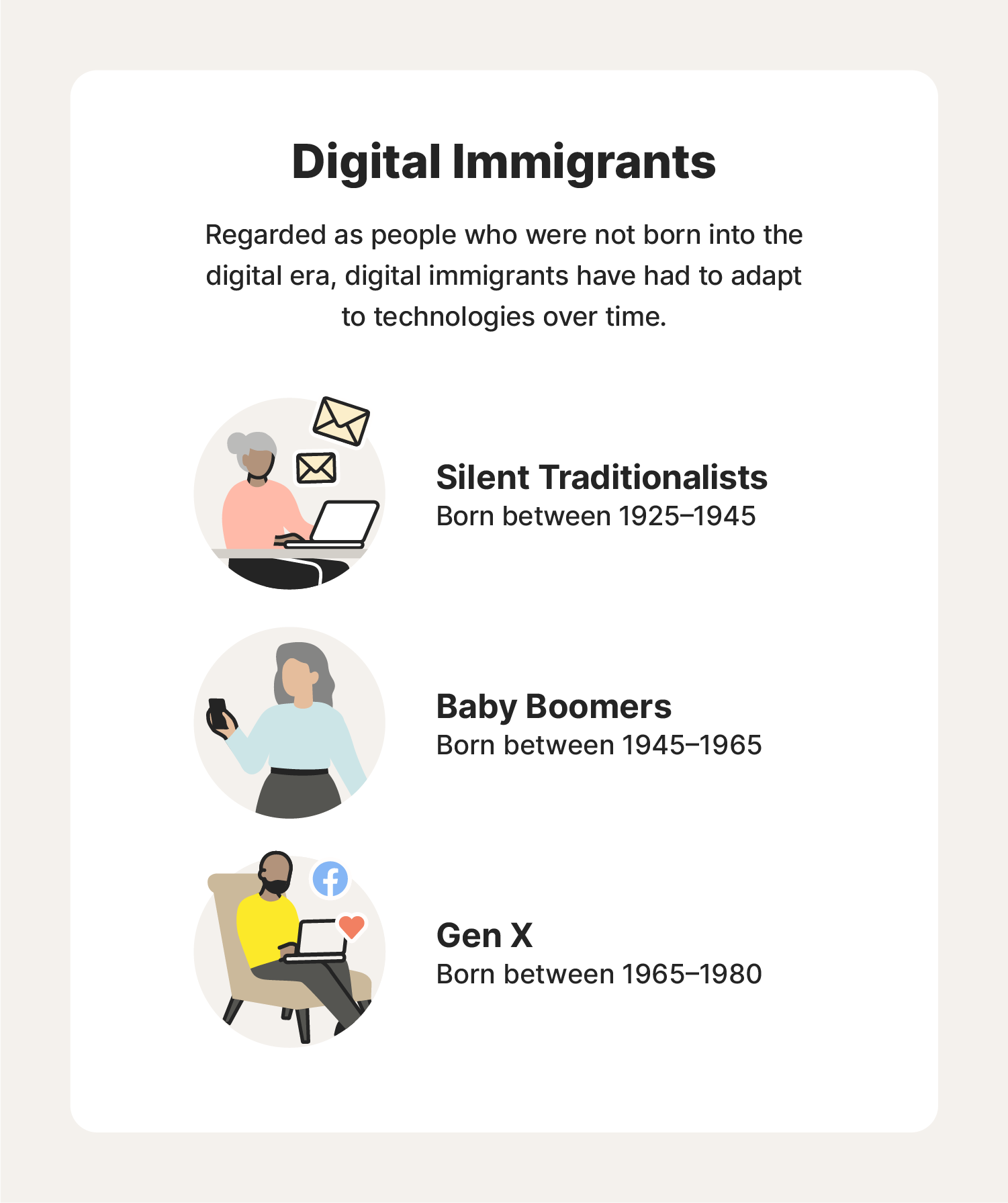
Digital immigrants were born or raised in an era before the world started turning toward a tech-first society. They do remember a world before the internet was on the rise, which means Gen X, Baby Boomers, and Silent Traditionalists, are all considered digital immigrants.
Incorporating technology into their daily lives is not so inherent for these digital generations. They’ve had to learn to adapt to the digital-first world and sometimes are skeptical of doing it, oftentimes considering old-school solutions before humoring new-wave conveniences.
To go back to our cup of sugar example, digital immigrants might first think to knock on a neighbor’s door for a cup of sugar versus ordering an entire bag online or even texting a neighbor for a cup.
Generally, digital immigrants are also slower to leverage the internet or connected devices and they’re also sometimes less aware of how they work in the first place — and the threats associated with them.
The anatomy of a digital native
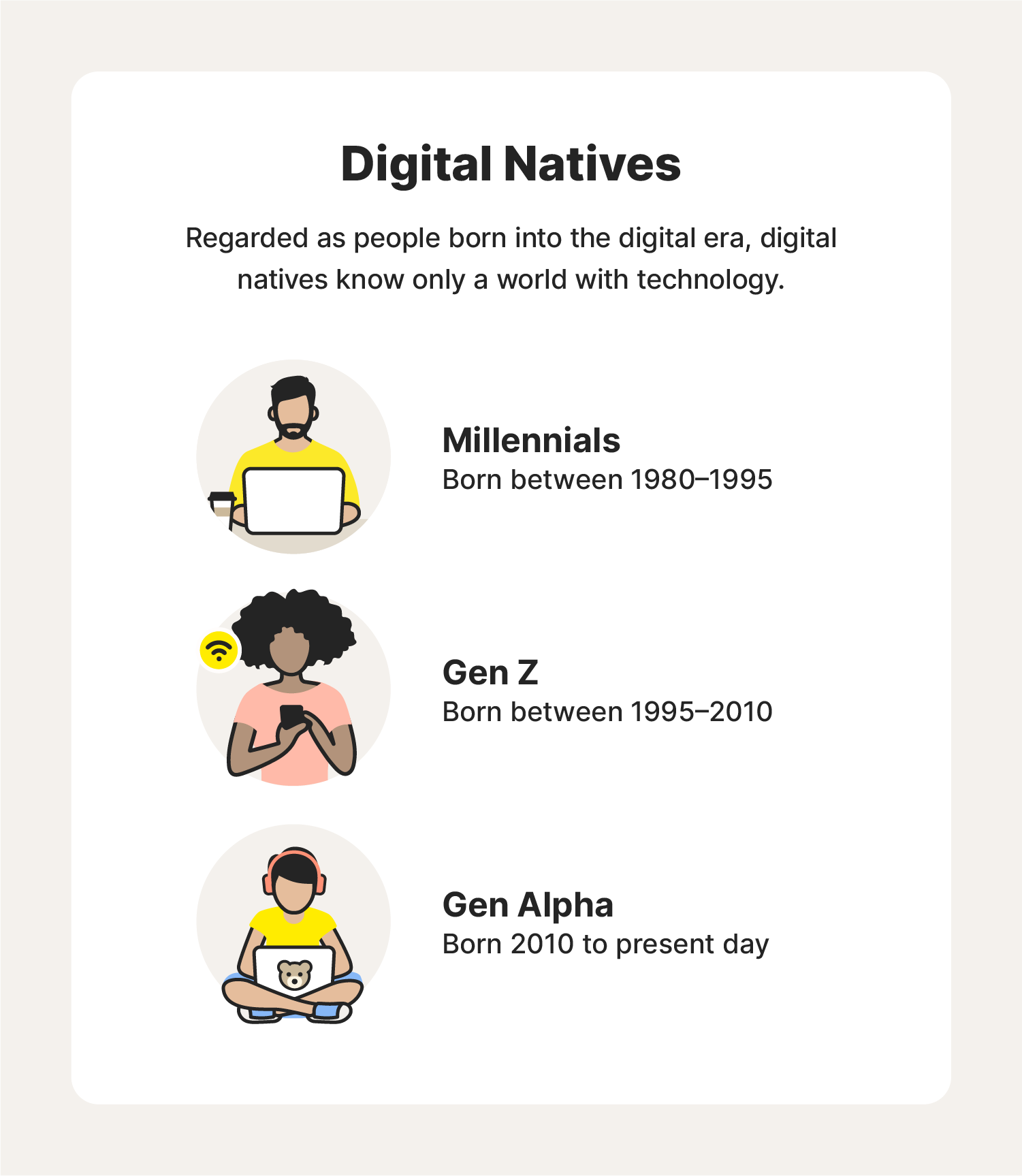
Digital natives know no world other than a digital-first one. They’re typically more fluent in tech talk because they were born into or raised in the digital era, meaning when there was widespread access to the internet and devices like computers and smartphones readily available.
To digital natives, adapting to the evolution of technology is inherent, but that doesn’t always mean they’re aware of the threats associated with new internet and device advancements.
So, what age groups are digital natives? Most regard digital natives as people born after the internet was developed in the early ’80s, which means Millennials, Gen Z, and Gen Alpha all are considered digital natives.
For a more concrete example, digital natives are people who opt to have a bag of sugar delivered to their doorstep using an app versus asking a neighbor for a cup.
Technology use statistics across digital generations
Technology is ever-evolving and each digital generation adapts to these advancements at their own pace, whether it’s toddlers tuning into YouTube Kids on a tablet or seniors preferring email over texts to stay in touch with family.
To paint a clearer picture of how each digital generation fits into our digital-first world today, we’ve rounded up technology use statistics across each generation. For due diligence, we’ve also put a cyber safety spin on the data to shed light on some of the risks these generations might face, plus remedies to help protect their online activities.
As the saying goes, let’s respect our elders and address the oldest digital generation first.
Silent Traditionalists and technology
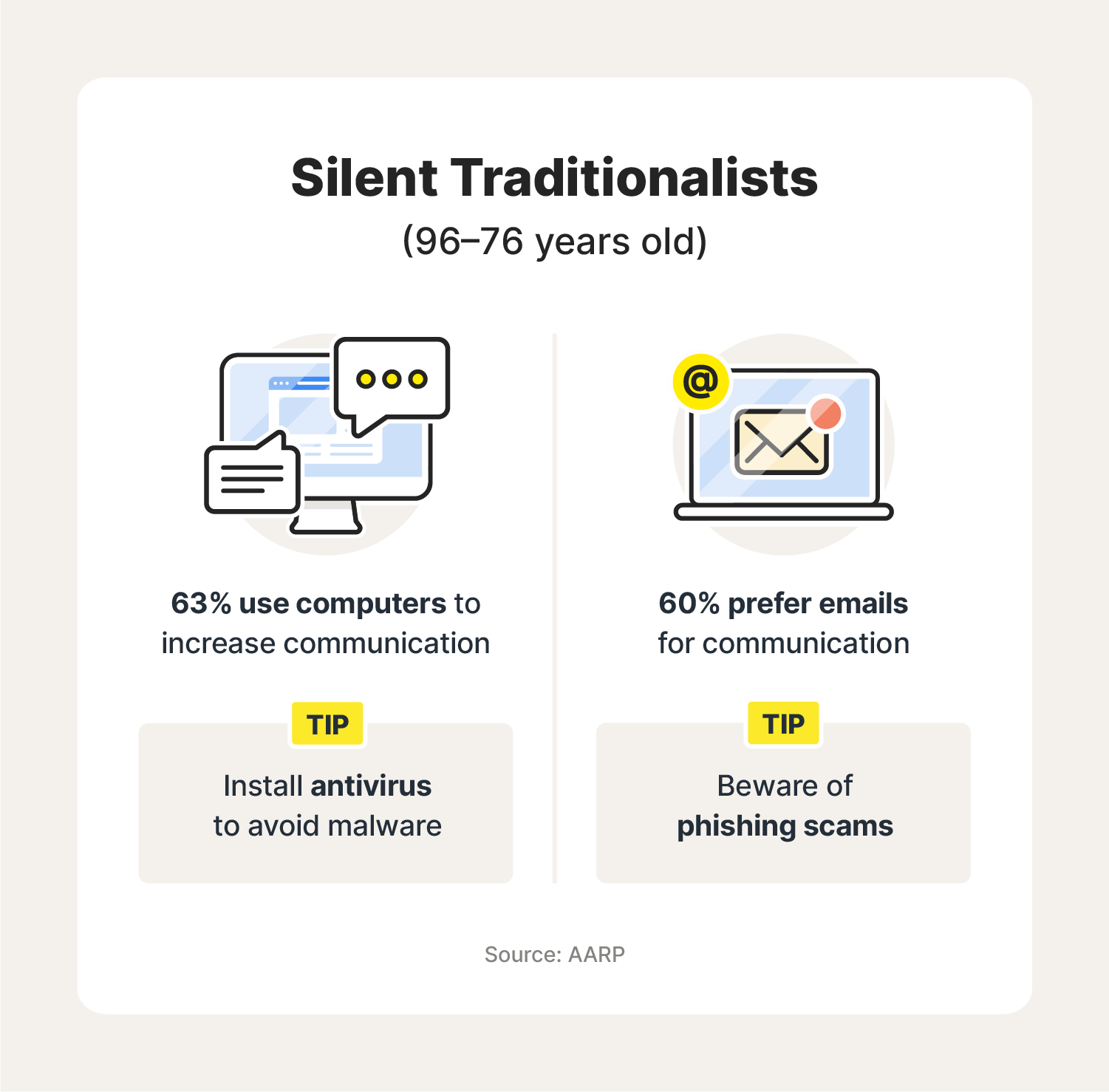
Born between 1925–1945 — years of war and depression — Silent Traditionalists are considered the oldest living digital generation. The jukebox was perhaps the most-used piece of technology when they entered the world. Nowadays, data shows that Silent Traditionalists turn to technology mostly to stay in touch with families.
For perspective on how even the youngest of Silent Traditionalists interact with technology, according to an AARP study:
- 63 percent of Silent Traditionalists say going online increases communication with family members and 56 percent use a computer to connect with people.
- Still Silent Traditionalists aren’t using social media to stay connected, as 40 percent avoid or do not use social media sites altogether.
- Instead, Silent Traditionalists prefer email most in terms of digital communications, with 60 percent indicating so. (Worth mentioning is that 72 percent of Silent Traditionalists prefer using a phone above all to stay in touch with others.)
Cyber safety risks and remedies for Silent Traditionalists
Considering Silent Traditionalists most often turn to computers and email for the sake of communication, there are a few common internet scams this digital generation should watch out for.
The risks: Tech support scams can occur on computers, especially in the form of malicious pop-ups that indicate you need to download software to correct a computer virus. It might be an attempt to download malware on a device.
Another risk to Silent Traditionalists, phishing scams often show up right in our inboxes and are messages from an illegitimate source asking for your personal information perhaps in an attempt to commit identity theft.
The fix: Installing antivirus software on a device can instill confidence in a user that their computer is already protected from pop-ups that might be malicious.
In addition, Silent Traditionalists should be aware of common signs of fraudulent emails — think misspellings, poor grammar, urgent demands with threats of financial consequences, and logos that don’t quite look right — and not interact with the email if they see these red flags.
Baby Boomers and technology
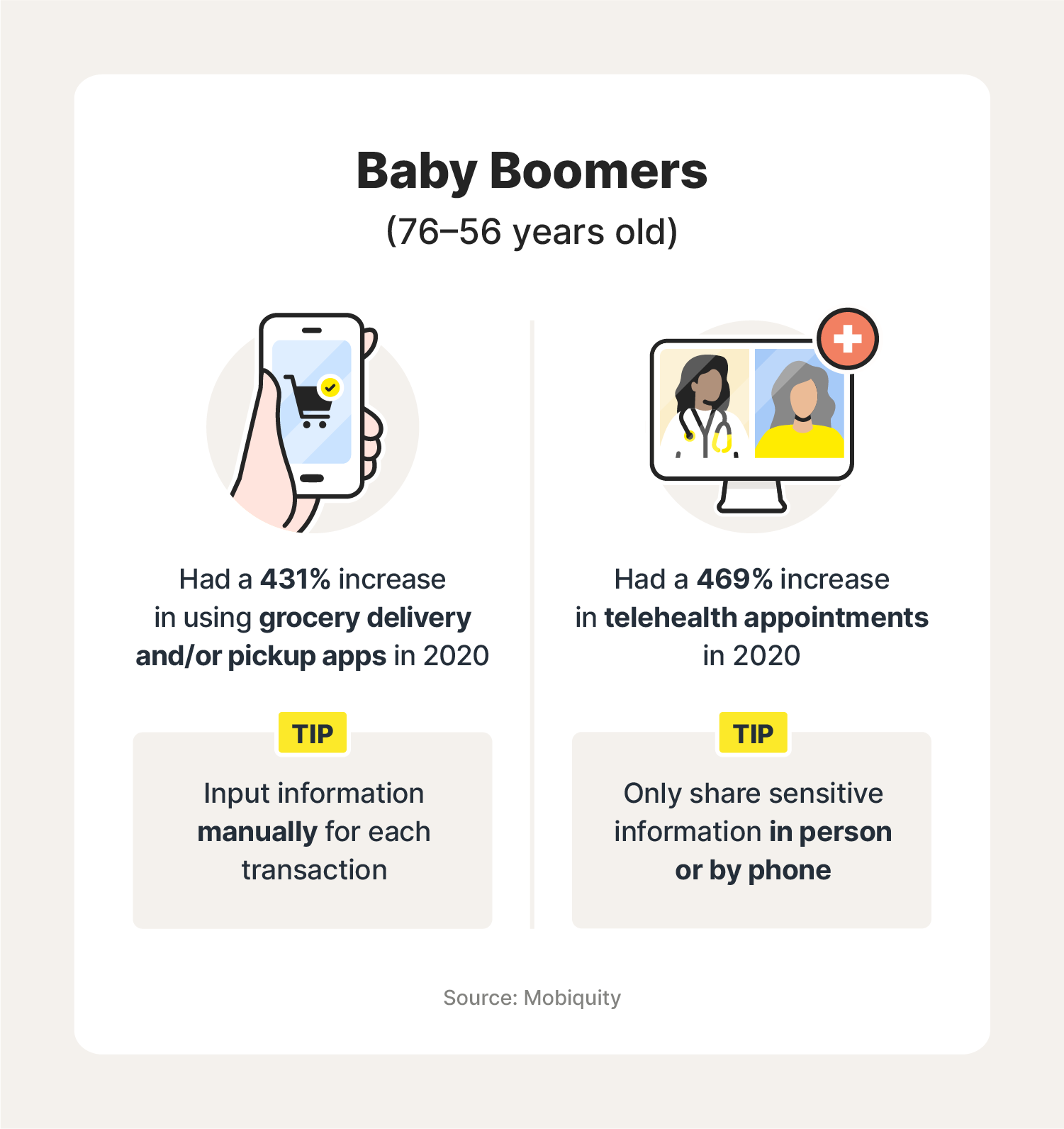
Born between 1945 and 1965, Baby Boomers entered the world on the tail-end of World War II and the upswing of the economy. This digital generation is most regarded for its work ethic and also being some of the first adopters of home computers.
While often more open to adapting to technological advancements than Silent Traditionalists, Baby Boomers are now more cozied up to technology than ever in light of the Covid-19 pandemic and have no intention of rescinding their tech-savvy ways.
For some context to how Baby Boomers use technology today, according to one survey during the pandemic:
- Baby Boomers showed a 431 percent increase in using grocery curbside pickup, meaning using an app or online service to order groceries.
- Baby Boomers showed a 469 percent increase in the utilization of telehealth.
- 88 percent of Baby Boomers say they will continue to use these types of technologies to make their daily life easier.
Cyber safety risks and remedies for Baby Boomers
When we turn to technology out of convenience, we sometimes pay for this by giving up our online privacy. Knowing how to safeguard information on common apps and platforms we utilize almost every day can go a long way in offsetting this.
The risks: The personal information we save in grocery delivery or pickup apps, including names, email addresses, delivery addresses, phone numbers, and payment methods, can be compromised in the event of data breaches.
In a similar vein, the medical and billing information we provide to our doctors online can also be at risk in the event hackers can intercept it during telehealth video appointments.
The fix: Instead of saving your personal information for later on grocery delivery or pickup app, opt to input your information manually for each transaction. Also, always use strong, unique passwords and opt for two-factor authentication (2FA) if it’s an option in these applications.
To protect your medical information, encourage your provider to only share this information with you by phone instead of via text or email and use a video-conferencing service that relies on encryption for telehealth appointments.
Gen X and technology
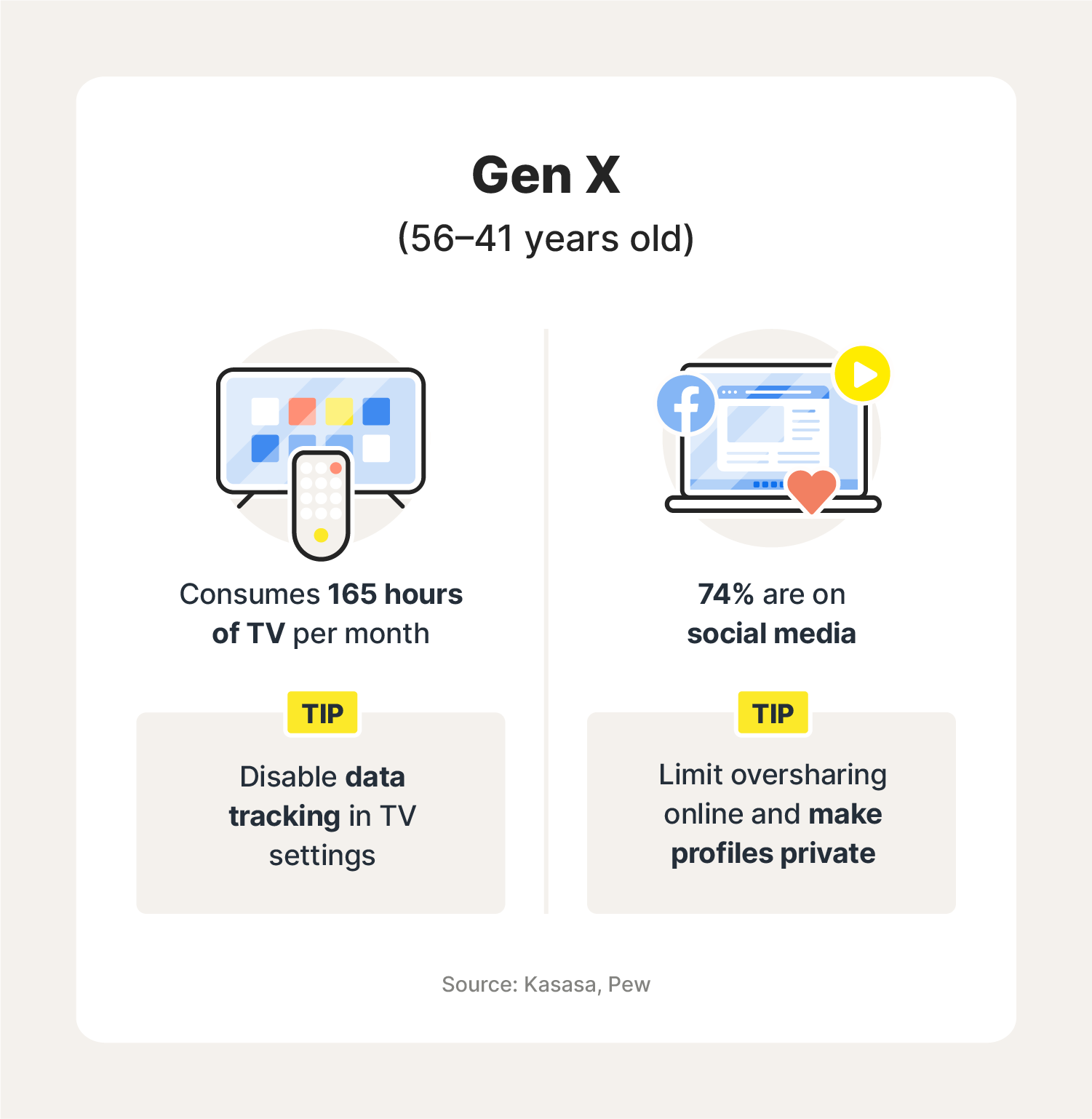
Born between 1965 and 1980, Gen X is also known as the latchkey generation for being brought up with little adult supervision. While still considered digital immigrants, Gen X was born on the cusp of when our world turned to a digital-first society.
Growing up, Gen X preferred email and phone calls for communication and they also were the first generation to embrace the Walkman. To the same tune, Gen X was also known as the MTV generation. Nowadays, Gen X continues to lean on technology mostly for communication but they’ve expanded beyond home phones.
For perspective about Gen X’s place in our digital-first world:
- Gen X embraced social media the fastest of all digital immigrants, with 74 percent of Gen Xers on social media today.
- Facebook is Gen Xers’ preferred social media platform, with nine in 10 Gen X social media users on it and spending roughly seven hours a week on the platform.
- True to their MTV Generation nickname, Gen X still loves TV, with Gen Xers watching about 165 hours of TV per month, including on smart TVs.
Cyber safety risks and remedies for Gen X
Sure social media’s wonderful to stay in touch with others, but it also can be a breeding ground for personal privacy complications, if you don’t know how to share responsibility. Likewise, TV is a great escape from our reality, but these devices too come with a few privacy risks to consider.
The risks: On social media, oversharing in your “about me” fields, such as including your date of birth or alma mater, and also documenting your every move makes it easy for others to piece together your identity — and possibly steal it.
On a separate note, today’s standard TVs that are smart TVs with internet-connected, voice-enabled features can track what you are searching and watching.
The fix: When it comes to social media, less is more in terms of protecting your privacy. Know that you don’t need to fill out every detail about yourself in those “about me” fields. Moreover, set your profile to private to ensure you’re approving anyone who follows your activity.
Similar to social media privacy settings, check your smart TV settings and disable the data tracking to keep your data, well, yours.
Millennials and technology
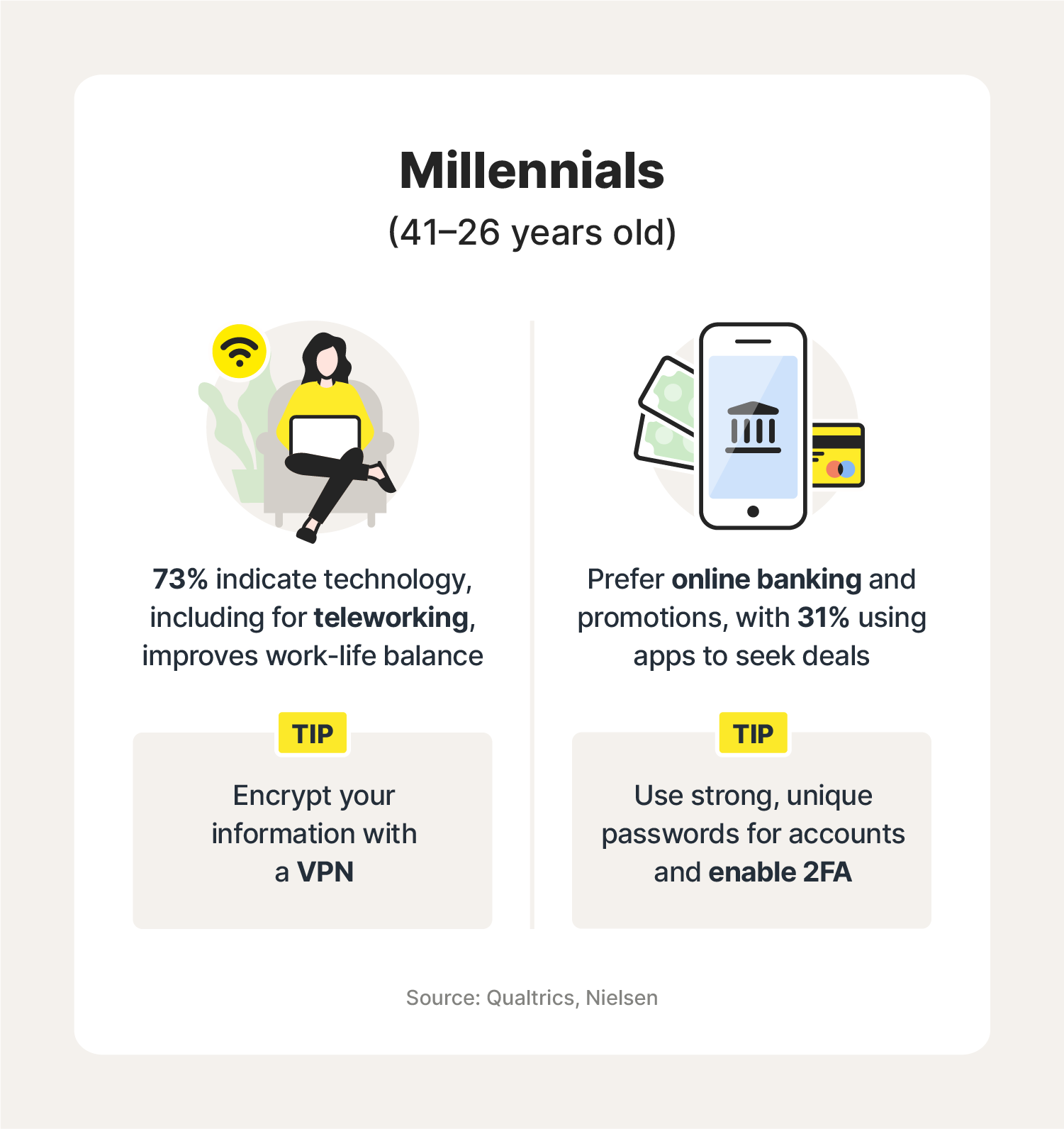
Born between 1980 and 1995, Millennials are the first true digital natives, as the oldest of Millennials were born on the advent of the internet and the youngest on the advent of smartphones.
The first adopters of social media — hence their Selfie Generation nickname — Millennials are also thought to be overly pampered by their parents who allowed them to embrace new devices and platforms in grade school and beyond.
Nowadays, Millennials remain with a tech-first mindset. For perspective:
- Millennials have mixed emotions about technology and work, with 73 percent saying it makes their work-life balance easier and 43 percent considering it a threat to their positions.
- 68 percent of Millennials are on social media, with 51 percent taking time out of their workday to use social media at the office.
- Millennials are the heaviest internet bankers of all generations, and they also prefer finding deals online — 31 percent of Millennials use apps to seek out promotions.
Cyber safety risks and remedies for Millennials
We can think of Millennials as technology’s biggest advocate — they were more willing than any generation before them to embrace digital advancements in the workplace and also outside of it for remote work and personal purposes.
Of course, entrusting connected devices and cloud-based platforms with so many facets of our lives means we need to be very cyber-wise.
The risks: Remote workforces rely on cloud-based platforms and video conferencing services to keep teams connected, both of which are some of the hackers’ favorite starting points for committing a data breach.
Cybercriminals also know precisely where to find your most sensitive information — your financial institutions — and if they get their hands on it, they could commit identity theft or even extortion.
The fix: When at work, whether it’s from home or in an office, always be aware of your webcam and what it could be exposing. Also, for work and personal purposes like online banking, use a virtual private network (VPN) to ensure your sensitive information is encrypted.
When banking online also protect your accounts by using strong, unique passwords, and change them often. Enable 2FA, if it’s an option.
Gen Z and technology
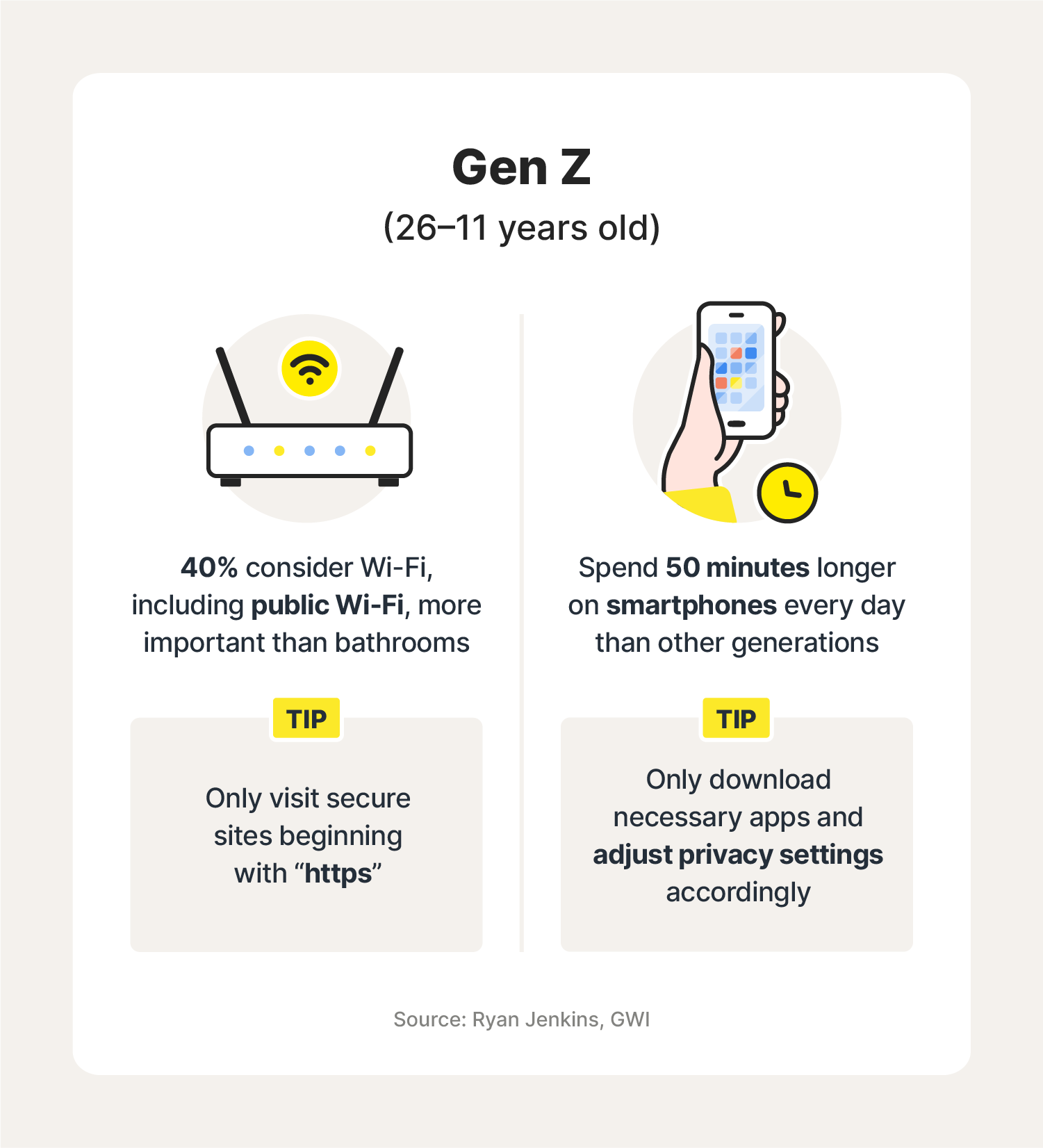
Born between 1995 and 2010, Gen Z has little to no memory of a world without smartphones. Their parents are Gen Xers, after all, and some of them maybe even started documenting their Gen Z childrens’ lives on social media even before their kids could pronounce the words Facebook or Instagram.
Nowadays, Gen Zers are the first to embrace these new platforms, welcoming Snapchat and Tik Tok quicker than generations before them, relying on YouTube and Netflix equally for entertainment, and considering video games a form of socialization.
For more perspective on how Gen Z is dependent on technology, consider that:
- The top website used by Gen Z is YouTube. Additionally, GenZers watch two times more videos on mobile devices than any other generation.
- Gen Zers spend an average of three hours 38 minutes online on their smartphones every day, which is almost 50 minutes longer than other generations.
- 40 percent of Gen Zers consider working Wi-Fi is more important to them than working bathrooms.
Cyber safety risks and remedies for Gen Z
Gen Z is perhaps the most technology-depending digital generation of all, with their smartphones serving as their most important tool to access the internet and all of its wonders. Of course, living with the internet at your fingertips means we must be aware of the risks associated with it.
The risks: Smartphones aren’t exempt from cyberattacks, especially when it comes to the apps we download and potential malware that comes with them or privacy settings that track our data.
Moreover, as Gen Z is so reliant on Wi-Fi, they may also be more likely to connect to public Wi-Fi, which can be dangerous since it’s often not encrypted.
The fix: Only download necessary apps and make a habit of adjusting the privacy settings accordingly to ensure you’re not oversharing your personal information such as your location.
In addition, be cautious of connecting to private Wi-Fi and only visit secure websites, meaning ones beginning with “https.”
Gen Alpha and technology
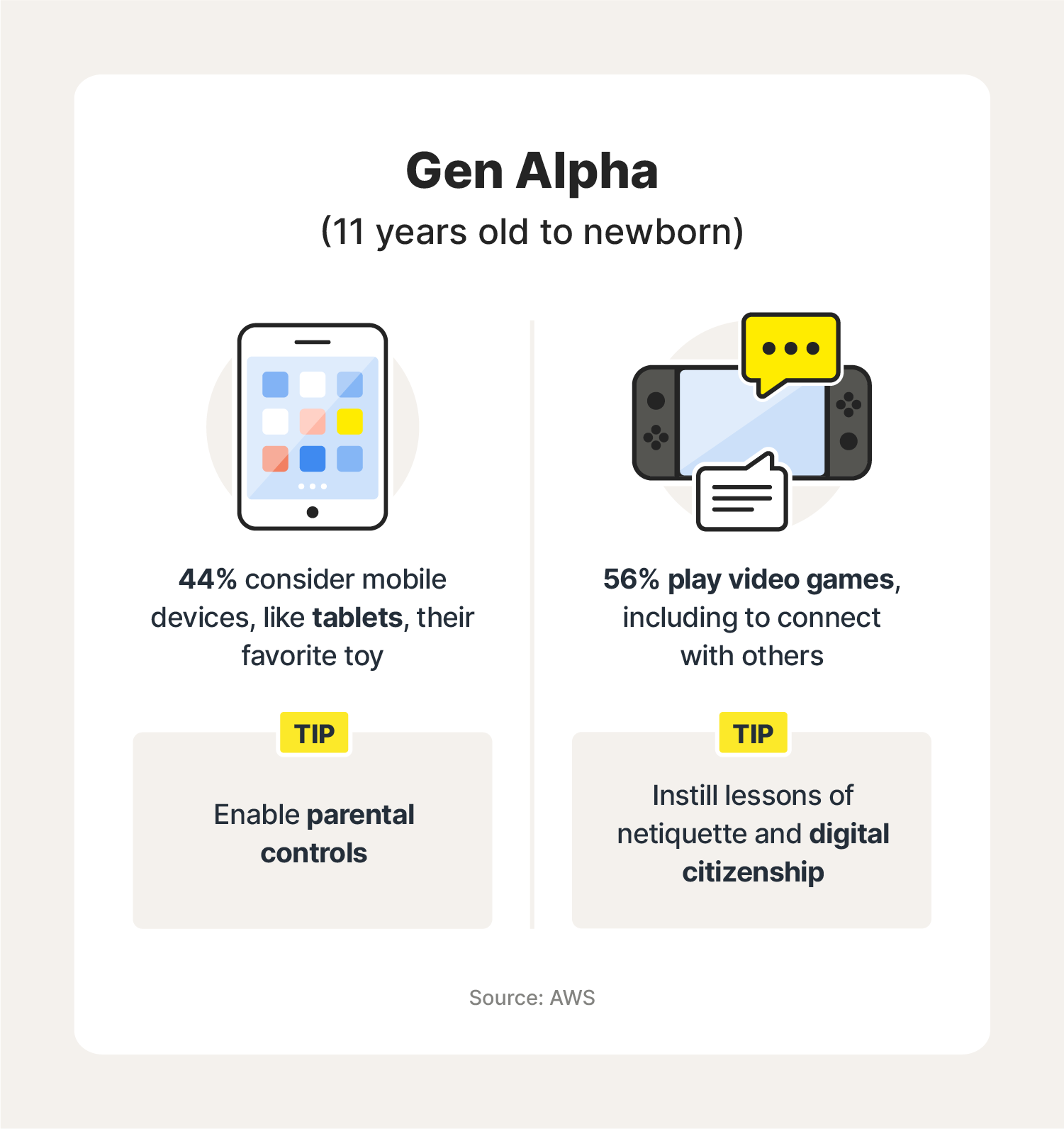
Born from 2010 to the present day — the only digital generation born entirely in the 21st century — Gen Alpha is also known as the Glass Generation because they can view their entire world through glass-fronted devices. And they begin doing that at a young age.
Worth mentioning is that today the oldest Gen Alpha members are only 11 years old, so much of their technology use is possibly monitored by parents, teachers, and guardians. For perspective on how Gen Alpha interacts with the digital world, one survey shows:
- 87 percent of Gen Alpha parents say access to the internet has helped kids perform better in school, including distance learning.
- 24 percent of Gen Alpha kids spend more time with their friends online than in person — including 56 percent of whom play video games — and 54 percent of Gen Alpha parents say tech helps their kids positively connect with other kids.
- 44 percent of Gen Alpha kids consider a mobile device such as a tablet their favorite “toy,” and 61 percent of Gen Alpha parents use this tech to “babysit” their kids.
Cyber safety risks and remedies for Gen Alpha
Access to technology comes with responsibility and for Gen Alpha kids that means it’s up to their parents to teach that responsibility in them, especially as this digital generation utilizes technology like tablets and video games for socialization and entertainment.
The risks: Some Gen Alpha kids might have cellphones but most begin with tablets as a form of entertainment. Depending on what apps and platforms they engage with, kids might also engage with other people on those devices — including some cybercriminals. The same is true for video games with chat rooms.
The fix: Setting parental controls on tablets can go a long way in limiting where your kids go online, including their video game security. But adults can’t be there to hold Gen Alpha kids’ hands through every online interaction.
For this reason, it’s worth instilling lessons of netiquette and digital citizenship in kids to ensure they understand the importance of protecting their identity and also red flags to watch for perchance they’re targeted by cybercriminals.
Remember, tech-savviness doesn’t necessarily run in the family. But cyber safety is something any digital citizen can practice, no matter which digital generation they fall in. Evaluating how we interact with technology is the first step in being aware of your cybersecurity, as well as how to remedy any risks associated with your online activity.
Bottom line: It’s up to every digital citizen — whether they’re a digital native or digital immigrant — to practice cyber safety and, in turn, instill it in digital generations to come.

Editorial note: Our articles provide educational information for you. Our offerings may not cover or protect against every type of crime, fraud, or threat we write about. Our goal is to increase awareness about Cyber Safety. Please review complete Terms during enrollment or setup. Remember that no one can prevent all identity theft or cybercrime, and that LifeLock does not monitor all transactions at all businesses. The Norton and LifeLock brands are part of Gen Digital Inc.


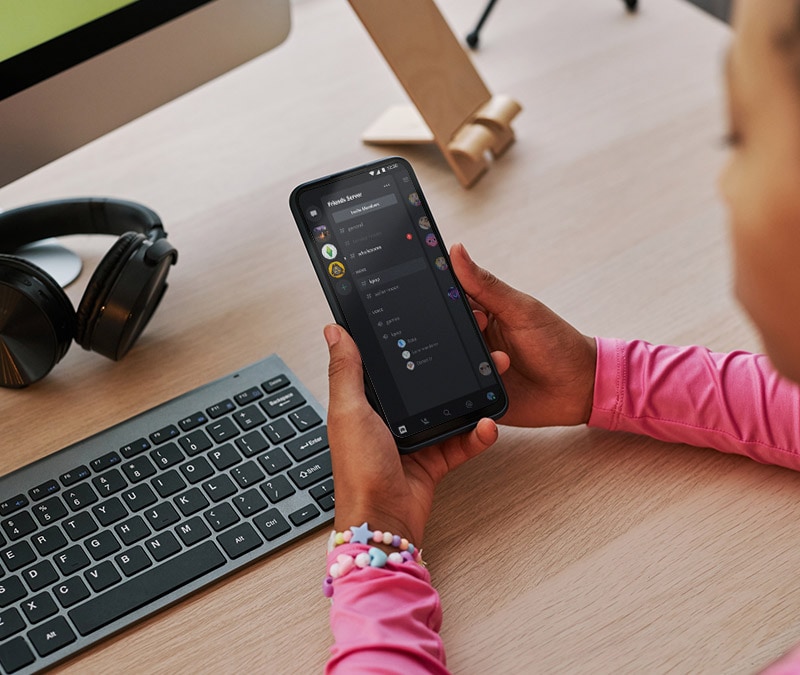


Want more?
Follow us for all the latest news, tips, and updates.